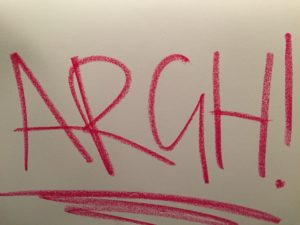
This is the fun part.
When I was little, I used to visit my Dad at his office and marvel over the array of pens and other stationery. It was my dream to grow up and work in a place with a magnificent stationery collection.
The great part of being an art therapist is the excuse to collect all sorts of artsy-crafty materials and PLAY with them!
If you spend your day typing documents or entering data into spreadsheets (as I used to) you can feel detached from the childlike fun of creative expression. Even if this part of you has been long forgotten, it’s still there! Art therapy is a great way to reawaken this innate urge for creative play.
As an adult, we are used to expressing ourselves like adults. Sounding ‘professional’. Being ‘serious’. Using big words (guilty). This leads to a dry lack of connection. We can intellectualise and filter our words and hide the emotional content from others and ourselves.
Why Use Art for Creative Self-expression?
Art materials are engaging in a sensory and emotional way. When you want to get out how you feel, or really describe your experiences you can talk about it or write about it (and I recommend this,  especially writing). But imagine the release you feel scrawling a red crayon across a large sheet of paper in big, zig-zag lines, a safe outlet for frustration “GRRRR”.
especially writing). But imagine the release you feel scrawling a red crayon across a large sheet of paper in big, zig-zag lines, a safe outlet for frustration “GRRRR”.
Engaging sensory and emotional experiences produce lasting change.
If you’ve ever read a self-help book and thought ‘fascinating, I understand’ like a detached observer of your own life, and then nothing changes then you are aware of needing to work through the feeling part for lasting effect. Sensory and emotional experience reinforces learning. The more immersive an experience you can learn from, the more it will stick. This is why it’s hard to remember the pages of procedure steps that you read, but if taught using a crisis scenario or corrected mistakes you’ll be sure to get it right the next time.
Art materials are so powerful that often it’s better to start gently, to reduce the risk of emotional overwhelm. You might not be ready to ‘see’ a picture of a traumatic experience and there is no need to revisit it. But when you’re ready to reinforce insights, or practice solutions, using engaging modalities like role play help prepare you for using new skills in real life. 
There’s no limit to the types of art materials that can be used in art therapy. Conventionally there are paints, pencils, crayons. But what about glitter, felt, popsticks, pipecleaners, rocks, masks, role play, movement, sound?
In my travelling toolkit I bring as much as I can fit so I have as much choice as possible when working with a client. I also check for allergies and if you have a particular aversion to a material that is ok, we can find one that you can work with.